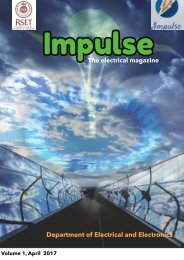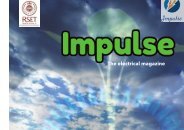impulse-ed 2-060417
You also want an ePaper? Increase the reach of your titles
YUMPU automatically turns print PDFs into web optimized ePapers that Google loves.
IMPULSE 2017<br />
DEE, RSET<br />
ELECTRIC SPRING (ES) - A PROMISING SMART GRID<br />
TECHNOLOGY<br />
Most PV systems are set up to disconnect from the grid whenever they detect a significant fault.<br />
If a single home’s PV system trips off-line, it’s only a headache for the owner. But if hundr<strong>ed</strong>s or<br />
thousands of them do so simultaneously, it could upset the network’s delicate balance, turning an<br />
otherwise small disturbance into an outage blacking out an entire city or county. Throughout much<br />
of the develop<strong>ed</strong> world, electric utilities are facing an unprec<strong>ed</strong>ent<strong>ed</strong> challenge. Growing numbers<br />
of customers are installing solar PV systems on their homes or businesses. The power they’re<br />
injecting into distribution lines is causing voltage- and frequency-control problems that threaten<br />
to destabilize the grid. While this is not yet a major problem, it could become one as distribut<strong>ed</strong><br />
solar systems proliferate. The cause of the problem is the inverter, an electronic system that<br />
converts the direct current (DC) suppli<strong>ed</strong> by the PV panels into the alternating current (AC) that<br />
flows on the power grid. Although they supply AC at the right voltage and frequency to sync with<br />
the distribution grid, they are otherwise passive. They can’t sense what is happening on the grid<br />
and adjust themselves accordingly. But newer “smart” inverters can prevent a PV system from<br />
going off-line when it doesn’t have to. By doing so, they can actually make the grid more stable,<br />
by preventing the sudden deterioration of voltage and frequency that would otherwise occur when<br />
hundr<strong>ed</strong>s or thousands of PV panels are suddenly taken off-line.<br />
Smart inverters are pois<strong>ed</strong> to fill a big ne<strong>ed</strong> in the fast-evolving electric-utility industry. As more<br />
and more homeowners put PV panels on their roofs, the power they are supplying is r<strong>ed</strong>ucing the<br />
ne<strong>ed</strong> for big, centraliz<strong>ed</strong> generating plants. The upshot is that increasing numbers of these<br />
traditional power plants are getting retir<strong>ed</strong>, and grid operators are scrambling for ways to keep<br />
their networks running with the same high level of reliability that their customers have long taken<br />
for grant<strong>ed</strong>. The combination of smart inverters and new control methods will be essential for<br />
helping utilities transition to the grid of the future, in which vast amounts of wind- and solargenerat<strong>ed</strong><br />
electricity will be the norm. A smart inverter can “ride through” voltage or frequency<br />
dips and other short-term grid disturbances and if these inverters have communications<br />
capabilities, they can let grid operators monitor and control them in response to changing<br />
conditions.<br />
The power grids of the future may ne<strong>ed</strong> advanc<strong>ed</strong> inverters that don’t simply follow what the grid<br />
is doing but actually help form the grid, by responding instantaneously to disturbances and working<br />
in concert to help keep the grid stable. This approach, known as Virtual Oscillator Control (VOC),<br />
was develop<strong>ed</strong> by an NREL team l<strong>ed</strong> by Brian Johnson working with Sairaj Dhople of the<br />
University of Minnesota; Francesco Bullo at the University of California, Santa Barbara; and<br />
Florian Dörfler at ETH Zurich.<br />
The basic idea behind VOC is to leverage the properties of oscillators—that is, anything that moves<br />
in a periodic fashion, such as a mechanical spring, a metronome, or a motor. When two oscillators<br />
are pair<strong>ed</strong>, or coupl<strong>ed</strong>, their motions will naturally align and picture several weights hanging from<br />
springs that are connect<strong>ed</strong> to a rigid and fix<strong>ed</strong> board. As the weights are given a pull to set the<br />
springs bouncing, the springs will tend to bounce in an uncoordinat<strong>ed</strong> fashion. However, if the<br />
board itself is suspend<strong>ed</strong> from the ceiling on springs, it becomes a fe<strong>ed</strong>back mechanism that<br />
responds inversely to the pushes and pulls from the bouncing weights. Within a short period of<br />
time, the weights will all start bouncing at the same frequency, all in lockstep.




